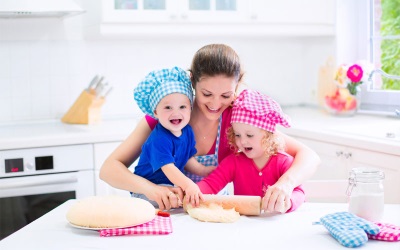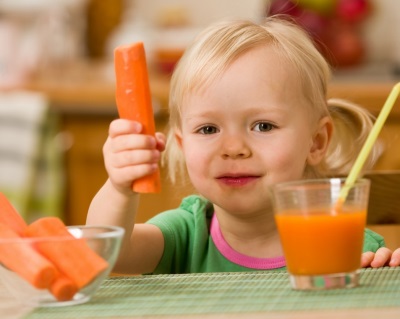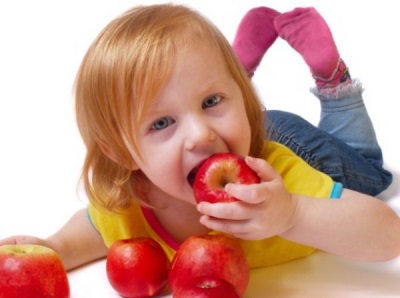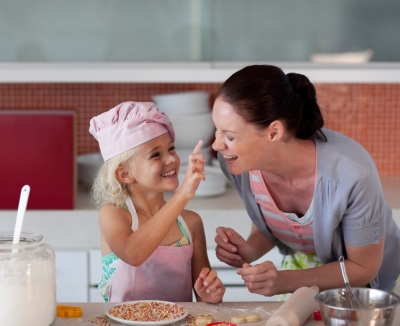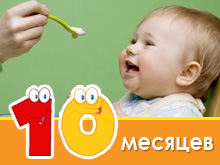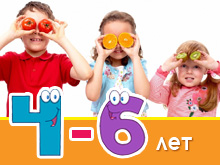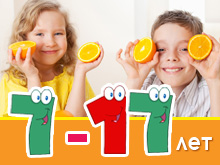Preschooler’s menu: principles of feeding a child from 4 to 6 years old
Children 4-6 years old are moving a lot and are also actively growing, so their energy expenditure and the need for building material should be provided with a sufficient amount of food. Let's look at how many times a child of this age should eat, what kind of food should be prepared for children from 4 to 6 years old and how best to build a menu.
Principles of proper nutrition
A balanced menu for a preschool child is very important. It will not only provide the nutrients necessary for growth, but also support the work of the entire body of the baby, including immunity.
The main nuances to which attention should be paid to the parents of preschool children are the following:
- The caloric content of food eaten by a child of 4 years should be about 1,700 kcal, for a 5-year-old child, about 2,000 kcal, and for a six-year-old child - about 2,200 kcal.
- Daily caloric intake is distributed to meals in this way: 25% of calories for breakfast and dinner, about 40% of calories for lunch and only 10% of calories for snack.
- It is especially important for a growing body to get enough protein - from 3 to 3.5 g per kilogram of weight. Protein rich foods are cottage cheese, meat, eggs, fish, dairy products.
- No less important are the fats coming from food. Their child should consume about 3 g per pound of mass per day. The main intake of fats is provided by the inclusion of vegetable and butter in the baby’s diet.
- Carbohydrates for a preschooler are the main source of energy. Their consumption rate is 15 grams per kilogram of child's weight. Their sources are cereals, fruits, bread, vegetables, sweets.
- A child of preschool age should eat meat, bread, butter, dairy products, fruits and vegetables daily.
- Products such as fish, cottage cheese and chicken eggs, give the child 2-3 times a week.
- In the diet of the child is to minimize the amount of food with artificial chemical additives. The simpler are the ingredients from which the food is prepared for the child, the healthier the dish will turn out for the baby.
Preschool children should not add vinegar, mustard, pepper, horseradish to dishes. They irritate the mucous membranes of the digestive tract.
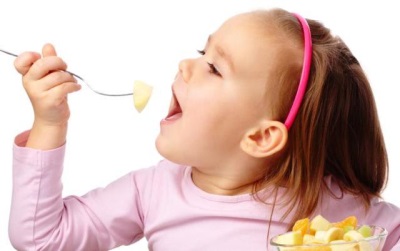
Child needs 4-7 years
A child of preschool age should receive the following products per day:
Product | Recommended amount for 4-6 year old child |
Vegetables | 250-500 g |
Bread | 170g |
- including black | 60 g |
Groats and pasta | 50 g |
Fresh fruits | 150-200 g |
Dried fruits | 15 g |
Flour | 25 g |
Meat | 110 g |
Milk and dairy products | 500 g |
Eggs | Half an egg or 2 quail |
A fish | 50 g |
Cottage cheese | 50 g |
15 g | |
Butter | 30 g |
Sugar | 60 g |
Vegetable oil | 10 g |
Sour cream | 15 g |
Salt | 3 g |
Fluid in the diet
Drinking regimen is very important for a preschooler. The child should use 60 ml of liquid for each kilogram of his weight. The optimal amount of drinking for a child 4-6 years old is 1.5 liters. Let the child drink more than usual water, but also in his diet there may be fresh juices, weak tea, coffee substitute (chicory), compotes of dried, frozen or fresh fruit, jelly, fermented milk drinks, milk. It is better not to give sweet soda to the child.
What can not be included in the diet?
A child of 4-6 years should not be given:
- Very spicy dishes.
- Coffee.
- Fast food.
- Mushrooms
Limit the use of chocolate, smoked meats, pickled foods and pickles by a child of this age. sausages and sausages.

What are the best ways to cook?
Although 4-6-year-old children can be given fried dishes, such a treatment for cooking for children should be applied at a minimum. The best way to prepare meals for preschoolers is called roasting, steaming, stewing and boiling.
Diet
From the age of 4, the child has a four-day meal schedule, including breakfast, a fairly hearty lunch, a small snack (afternoon tea), and a not-so-rich dinner. Some children have additional snacks in the form of a second breakfast or meal before bedtime.
The child should be fed in such a way that the preschooler gets food at about the same time every day, even at the weekend. Do not allow breaks longer than 4-6 hours. If the child goes to bed at 21 o'clock, then his dinner should be no later than 19-30.
How to make a menu?
Thinking through the nutrition of the child during the day, you should try to provide all the needs of the baby and at the same time make the preschooler's food varied and tasty:
- For breakfast, a child of 4-6 years old gets 250 g of the main course, which can be presented as porridge, cottage cheese dish, and omelette. Also, for breakfast, preschool children usually get 200 ml of drink and a sandwich.
- Lunch of a preschooler usually includes 50 grams of vegetable salad or other snack, 200-250 ml of the first dish, 60-100 g of meat or fish dish with 120-150 g of garnish, and a drink in a volume of 150 ml and up to 90 g of bread.
- At lunch the child receives cookies, a muffin, fruit, kefir, milk, jelly. The volume of the drink is 200 ml, and baking - 25-60 g.
- The main course for dinner is often cereals and vegetables. The child receives this dish in the amount of 200 g. To him give 40 g of bread and 150 ml of drink.
- Combine dishes in the daily menu so that one type of food does not repeat during the day. For example, if there was porridge for breakfast, then offer vegetables for lunch with a side dish, and if there was cereal for lunch with meat, then dinner should include a vegetable dish.
- At dinner, you should not give heavy for digesting dishes, such as meat or dishes from legumes.
- It is optimal to make the menu not for one day, but for a whole week, as some dishes give only 1-3 times a week.
Sample menu for the week
A child aged 4-6 years old can eat for a week like this:
Day of the week | Breakfast | Dinner | Afternoon tea | Dinner |
Monday | Homemade muesli with dried fruits with milk (250 g) Tea with honey (200 ml) Bread and butter (40 g / 15 g) | Carrot and Cabbage Salad (50 g) Soupcauliflower puree (250 ml) Rabbit in sour cream (80 g) Boiled rice (130 g) Pumpkin Kissel (150 ml) Bread (90 g) | Kefir (200 ml) Bun with curd (60 g) | Pumpkin Potato Casserole (200 g) Tea with milk (150 ml) Bread (40 g) |
Tuesday | Wheat milk porridge (250 g) Cocoa with milk (200 ml) Bread and butter (40 g / 15 g) | Green Pea Salad (50 g) Beetroot (250 ml) Baked fish (100 g) Braised Cabbage (130 g) Grape juice (150 ml) Bread (90 g) | Fruit Salad (100 g) Yogurt (150 ml) Cookies (25 g) | Potato zrazy with liver (200 g) Milk (150 ml) Bread (40 g) |
Wednesday | Carrot-curd casserole (250 g) Tea with milk (200 ml) Bread and butter (40 g / 15 g) | Cucumber, radish and egg salad (50 g) Vegetable soup (250 ml) Fried liver with onions (60 g) Boiled Cauliflower (130 g) Compote of plums and pears (150 ml) Bread (90 g) | Milk (200 ml) Bun with raisin (60g) | Buckwheat milk porridge (200 g) Kefir (150 ml) Bread (40 g) |
Thursday | Semolina with berries (150 g) Omelette (100 g) Chicory with milk (200 ml) Bread and butter (40 g / 15 g) | Potato Salad (50 g) Borsch (250 ml) Fish Cutlet (80 g) Vegetable Stew (130 g) Peach juice (150 ml) Bread (90 g) | Kefir (200 ml) Bun with apples (60 g) | Cottage Cheese Pudding (200 g) Tea with honey (150 ml) Bread (40 g) |
Friday | Oatmeal with raisins and nuts (250g) Tea with jam (200 ml) Bread and butter (40 g / 15 g) | Herring with butter (50 g) Vegetable soup (250 ml) Pasta and meat casserole (150 g) Compote of dried fruit (150 ml) Bread (90 g) | Baked Apple (100 g) Ryazhenka (150 ml) Cottage Cheese Cookies (25 g) | Peppers stuffed with rice and vegetables (200 g) Cocoa with milk (150 ml) Bread (40 g) |
Saturday | Grated apple with carrots and sugar (50 g) Barley milk porridge (200 g) Chicory with milk (200 ml) Bread with butter and cheese (40 g / 10 g / 20 g) | Beetroot Salad (50 g) Broth with egg (250 ml) Chicken Cutlet (80 g) Mashed potatoes with green peas (130 g) Cherry Jelly (150 ml) Bread (90 g) | Milk (200 ml) Buns (60 g) | Stewed courgettes (150 g) Squid rolls (50 g) Tea with jam (150 ml) Bread (40 g) |
Sunday | Cheesecakes with apple and sour cream (250 g) Tea with milk (200 ml) Bread and butter (40 g / 15 g) | Cabbage salad (50 g) Potato soup (250 ml) Boiled beef (100 g) Buckwheat porridge (130 g) Tomato juice (150 ml) Bread (90 g) | Kefir (200 ml) Oat cookies (25g) | Omelet with tomatoes (100 g) Spaghetti (100 g) Chicory with milk (150 ml) Bread (40 g) |
Recipe examples
Carrot-curd casserole
Wash and clean 200 g of carrots, chop it into strips. Sprinkle on butter (10 g), add the semolina (10 g) and cook until ready. Into the cooled carrot mass, beat in a raw chicken egg, add 80 g of cottage cheese and 2 teaspoons of sugar, mix. Put in a fireproof container, brush with sour cream (10 g) and bake until cooked in the oven.
Winter Fruit Salad
Wash one red apple, peel one banana, one grapefruit and one orange. Slice all fruit and mix. If the salad will not be served immediately, do not add a banana (slice and place it before serving).
Pancakes with vegetables
One egg, 6 g of sugar, a pinch of salt and 75 g of flour mix well, add 150 ml of milk. From the resulting smooth dough, bake the pancakes and let them cool. At this time, prepare the vegetable filling. Chop cabbage (150 g), onions (30 g) and carrots (120 g). Fry the vegetables in vegetable oil (5 g) until soft and salt a little. Place minced vegetables on the center of the pancake, wrap in an envelope and fry lightly in a frying pan.
Possible problems
Inadequate consumption of fresh vegetables, as well as fruits, by the preschooler can cause constipation. Raw plant food is useful for digestion and strengthening the child’s immunity, so parents should make sure that such food is on the children's menu.
Most children of this age have already formed certain tastes and preferences, and children categorically reject some dishes. Do not make the child eat foods that he does not like. For the time being, eliminate "abandoned" dishes from the diet in general, and eventually offer again.
If the child has no appetite, first find out if there are any objective reasons for this. Perhaps the previous meal was too nourishing, the room is very hot, the child fell ill or in a bad mood. Wait until the appetite appears, and you do not need to force. This not only can cause a negative reaction to food intake, but also worsen the child's digestion.
In children, the appetite, by contrast, is elevated. But to rejoice at the desire of the child to eat large portions is also not necessary. This can cause weight gain, limiting baby's mobility, curvature of the spine, the risk of stone formation and other health problems. If the child has already gained weight, consult with the pediatrician to correct the baby’s nutrition and his daily routine.
Tips
From 4 years old, you can add a child to cooking. A child of 4-6 years old can be charged with stirring cream, chopping vegetables, making patties, washing greens and roots, peeling peas and much more. It will also be interesting for the child to observe how the mother makes yogurt, cuts fish, decorates the cake.
Some useful tips:
- Buy only fresh and high-quality products for your child. Always keep track of the shelf life of the food that a preschooler eats. It is best to cook fresh food for a child of this age daily.
- If a child goes to kindergarten, find out the menu in the evening to supplement the baby’s diet with missing products, and also to ensure that your dinner does not repeat the dishes of the same-day garden menu.
- For a child attending the sports section, the amount of protein and carbohydrates in the daily menu should be increased. It is important to ensure that the child does not go to the training session hungry, and also does not eat immediately after the load. Immediately after a workout, it is advised to give to drink sweet fruit juice.
On the need to provide children with enough vitamins, read other articles:


